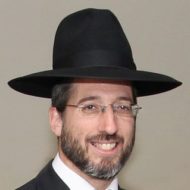
As business boomed for tailors in a busy street in London, four tailors decided to open up one after each other.
The first was George’s Tailor Shop. The sign read: The best tailor in the area!
The second was Edward’s Tailor Shop. The sign read: The best tailor in London!
The third was Johnson’s Tailor Shop. The sign read: The best tailor in the United Kingdom!
The fourth shop was opened by Yitzchak Cohen. He pondered and pondered as to what he would put on his sign, until he decided just to be honest and wrote: “Cohen’s – best tailors on the block!”
Sometimes modesty pays off.
In a world where the fight for survival and success is ever increasing, one might be forgiven for renouncing one of the most highly acclaimed characteristics – that of being modest.
How can one enter the 21st Century and succeed, if they are modest? Surely we need to show the world what we are made of and how amazing we are?
The Torah seems to take a different view.
Appearing at the beginning of our Parasha are the laws concerning the Shemita year in which the land is left fallow. We are commanded to observe the Shemita after having worked the land for six years. G-d promises His Blessing will rest upon the people that observe this Mitzvah: “Then I will command My blessing for you” (25:21).
What was the essence of this blessing and why did G-d need to affirm this specifically with regards to Shemita?
In the Torah modesty is viewed with such esteem that when the greatest person to ever live – Moshe Rabenu is praised, he is claimed to be the most humble of all men and “a servant of G-d”.
The Great Sage Hillel Hazaken was born in Babylon and, according to the Iggeret of Rav SheriraGaon (a comprehensive history of the composition of the Talmud from the 10th century), Hillel descended from the Tribe of Benjamin on his father’s side, and from the family of David on his mother’s side. One of the most important leaders of the Jewish people he was associated with the development of the Mishna – oral law.
The Gemara (Sukkot 28b) relates that Hillel HaZaken had eighty students – thirty who were described as deserving of divine revelation like Moshe Rabenu, thirty who merited the cessation of heavenly orbits as did Yehoshua bin Nun, and twenty intermediate students. The greatest of his students was Yonatan ben Uzziel; the youngest of them was RabbanYohanan ben Zakkai.
In what fields was the “youngest of the students” expert?
It was said of Rabbi Yohanan ben Zakkai that his studies included the written Torah, Mishnah, Gemara, Halakhot, and Aggadot; the subtle points of the Torah and the minutiae of the Scribes; the inferences from minor to major and analogies; astronomy and geometry (the simple meaning of the word in Greek is – land measurements, but it was commonly used to mean engineering or mathematics in general); the language of the ministering angels; the language of the demons, the whisper of the palms, washer’s proverbs and fox fables, and matters great and small.
The report on Yonatan ben Uzziel was that when he would sit and study Torah, a bird that flew above his head would immediately burn up.
On deeper reflection of this Gemara our Sages are perplexed.
If the fire burnt above the head of Yonatan Ben Uziel who was the student of Hillel Hazaken, then we would have expected much greater things to be occurring above the head of his teacher and Master – Hillel Hazaken. Why is there no mention about what happened above his head?
The answer is that in the case of Hillel Hazaken there was also a fire. Yet, he was so holy, so modest; his whole essence was to keep that fire and all around on a low key, quietly inside. It was not about the pump and publicity of being a tsaddik. On the contrary it was all about modesty, realising ones potential but not gloating or wanting even a secondary effect being shown to the outside world of his real greatness.
The Midrash Sifri (Devarim 357), points out that the periods of Hillel’s life are made parallel to those in the life of Moshe. Both lived 120 years, and at the age of forty Hillel went to the Land of Israel; forty years he spent in study; and the last third of his life he was the spiritual head of the Jewish people. There was a similar split of years regarding Moshe’s life.
Both were known for their modesty and both became successful leaders and bearers of the Torah.
In Shemita we were given a mitzvah that enables us to focus on modesty for an entire year!
The farmer was the master of his fields for six years. His fields were off-limits to the public, and through his hard work he sowed, reaped, collected and stored up his harvest and his fruits.
Yet when the Seventh year arrived, he was told to put everything down. The land he was so attached to had to be left fallow for a year. No longer was he the master of his possessions, and his fields were open to everyone. During the Shemita year, the farmer could not feel proud of his personal efforts and during that time he would conduct himself with modesty and humility, yielding before everyone, for each and every person was as much the master of his fields as he was, if not more.
It is at this stage that the Torah reaffirms that this person will be blessed. G-d will command His special blessing towards him.
When a cup is full, there is no place to pour any more liquid. Yet when the cup is emptying, it has plenty of space to receive. During this Shemita year the person works on his modesty ensuring he has created the space to capture G-d’s blessing. He is then rewarded with success.
In a society that prides itself on challenges and survival of the fittest, one would never have expected the survival of a nation who in their entirety let their land be open and unworked on every seventh year. We would have never expected the leaders of the Jewish people to have such modesty and humble character traits. The Torah teaches us that it is because of their character that they were the best on the block!
Shabbat Shalom







